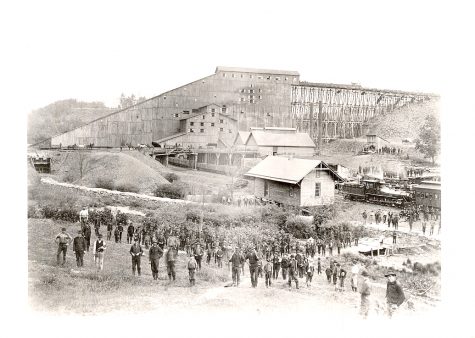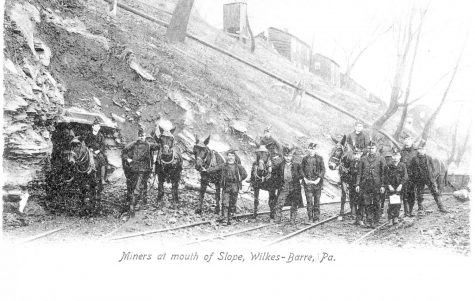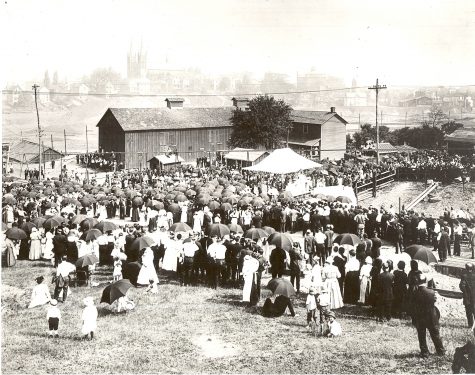Local historical mining photos discussed at art lecture
On Oct. 2, Dr. Aimee Newell, the Executive Director of the Luzerne County Historical Society, spoke at the Sordoni Art Gallery. Newell’s lecture, titled “Mining our History: What We Can Learn from Photos of the Past,” focused on mining-related photos and how they can teach researchers about our history.
Alongside that, Newell also focused on how the photos of the Luzerne County Historical Society resonate with the photos in the Rust Belt Biennial exhibit.
Newell began by talking about the history of photography and its creation. Although it began in 1824 in France, it is more commonly associated with Louis Daguerre in 1838 when he created the ability to create fixed images on a silver plate in thirty minutes. Newell continued to talk about the advancements in photography making note to highlight the importance of not just the images but also the photographers.
Newell began to explain the importance of photography in helping historians to understand history.
“None of these photos exist in a vacuum,” Newell began. “Even though they capture a moment in time, they form a context with other images and other sources of information.”
Newell transitioned into the history of coal mining in Pennsylvania to give context to the importance of coal mining in the Rust Belt, as well as in the city of Wilkes-Barre.
Newell explained that photography is a useful tool to gain knowledge about mining in Luzerne County. By the 1950s, when mining began to see its decline in the Luzerne County area, photography became an established and useful tool to capture images of everyday life, thus also documenting the tail end of the mining era.
“Photographs have no text, so we learn from them in a different way. We still need to read them but we have to ask, ‘Are all historic photos useful?’” Newell continued. “I would caution us that we need to analyze historic photos carefully.”
Newell continued to address how some photos can be doctored our taken with specific intent, before showcasing some images from the Luzerne County Historical Society’s collection.
One of the photos Newell showed was of the Glen Lyon Breaker, which showcased how the landscape of the area was altered due to the large breakers.

“End of Shift at Glen Lyon” captures miners as they leave the work place, giving historians more insight into the working life of miners in the rust belt.
“We can learn a lot about how the mining process worked. The breakers had conveyor belts that took the coal to be washed and sorted,” Newell continued. “In this photo, you can see the miners leaving at the end of the day and get a sense of who the miners were and the clothing they were wearing, which are things you cannot always learn from documents.”
Another photo Newell focused on was of miners of Wilkes-Barre walking along railroads with their mules. This photo highlighted the gear of the miners but also the housing in the background.

“Miners at Mouth of Slope” provides insight on mining equipment, as well as the residential areas of miners during the early 20th century.
“In addition to being able to learn about their gear and the gear for their mules, you can see the houses on the top of the hill which were probably patch houses, helping us learn about the living conditions of the miners,” Newell said.
Newell also showcased many other photos, some of younger workers, and other photos highlighting working conditions and the danger of coal mining.

“Baltimore Memorial Service” details the aftermath of a mine explosion, highlighting just one of the dangers of mine work.
Two photos, in particular, showcased the Knox Mine flood, a flood caused by miners digging too close to the Susquehanna River. The images featured both the rescue of miners and railroad cars filled with sediments which were used in an attempt to stop the flooding.
From both these photos, historians could gain information about the incident as well as how miners attempted to deal with mining disasters.
“The lecture opened my eyes to how important photography is to studying history and how important it is for studying select time periods,” said Morgan Johnson, sophomore psychology major.
As Newell closed her lecture she addressed how the Rust Belt area gained its name. The name described the people and struggles of the northeastern and northwestern United States, which were impacted by declining industry and falling population.
The photographers whose photos are featured in the Rust Belt Biennial attempt to reclaim the term to showcase that the Rust Belt is not inherently bad or ugly.
During a Q&A after the lecture, Dr. Jonathan Kuiken, assistant professor of global cultures asked, “Is there any way to know who the photographers were? Are they working for the companies, are they private photographers? Do we have any evidence or any way of knowing that?”
Newell addressed that there is no way to completely tell who may have taken every photo, again reinforcing her earlier point that photographs need to be analyzed carefully in a historical context.
Sean is a sophomore communication studies major who started as a staff writer in the fall of 2018. Sean currently works as the Assistant News Editor, a...